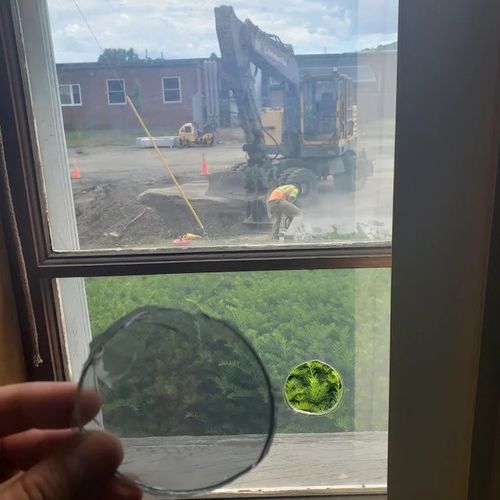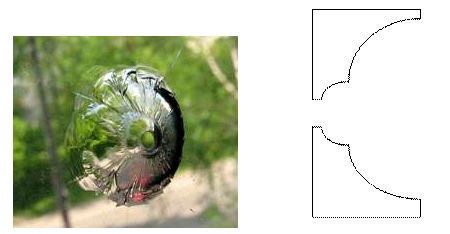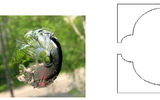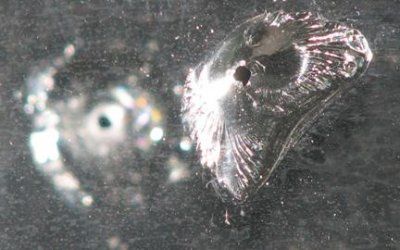
| Added | Fri, 14/04/2017 |
| Sources | |
| Феномены | |
| Version type |
On the windows of houses, regardless of the floor, there are holes of unknown nature and characteristic shape. Very often, if there are several glasses, only one is broken. At the same time, the inner honor of the glass is usually damaged more than the outer one. These holes are often associated with the phenomenon of poltergeist, and the phenomenon itself is called "ghost glazier" or "ghost sniper".
In fact, such holes are obtained as a result of the impact on the glass of balls from bearings, bullets from pneumatics and just small pebbles.
A very good explanation of this phenomenon was given by S.D. Varlamov (Department of Physics of MIOO) back in 2008:
The shape often found for holes, which begins with a small round hole and continues with a kind of "cone", is captured in numerous photographs. One of them is given below. Next to the photo is a schematic typical cut of a hole across the glass.
The prose of life is that this is the trace of a small pebble hitting the glass or (which happens much more often) a small steel ball fired from a slingshot or from an air pistol. A stone or a steel ball (in the future we will talk about a stone) remains on the other side of the glass from which the impact occurred, and the broken glass flies away in the opposite direction.
In the photographs and on the schematic "profile" of the chipped glass, it is noticeable that the "profile" hole is not a cone at all, but a figure formed by three axisymmetric surfaces. Let us describe qualitatively the sequence of occurrence of these surfaces.
The first is the side surface of a small hole, which has the shape of a cylinder with a relatively large diameter and a very small "height". Here the glass was thoroughly destroyed as a result of deformation of non-isotropic compression during the time of contact with the stone. The cracked glass from this area turned into fine crumbs after the rebound of the stone.
It is followed by a second surface with a small radius of curvature. It restricts the area of glass, which immediately after the "push" breaks away from the array of glass adjacent to the impact site. The separation is associated with a large relative deformation of the shear of the glass at the impact site. Glass has a "breaking" lower strength than "compression", so the surface of the "first" separation extends into the glass at distances greater than the area of glass destruction as a result of strong non-isotropic compression (which took place in the area of a small round hole). The glass material from this area gained momentum at the time when the stone touched the glass. Then the stone bounced off the glass, and waves appeared in the glass material, spreading from the impact site. Since with increasing distance from the impact site, the amplitude of the displacement of particles from the equilibrium position decreases, at some distance from the impact site, the material shift becomes insufficient for a "separation" to occur, and as a result, the first separation surface with a small radius of curvature "stops" inside the glass array and does not pass through the glass.
And finally, the third curved surface has a large "average" radius of curvature and is not smooth. It is formed after the wave of compression and shear in the glass reaches the surface of the glass opposite to that on which the stone hit, is reflected from it, and, having now turned into a wave of stretching, reaches the points of the first boundary of the "separation" farthest from the place of impact of the stone. In these places, in the presence of small cracks inside the glass volume, a very small tensile stress is required for the glass to break. Cracks grow rapidly inside the area in which there is currently a tensile stress. Since this area has a finite thickness (it is determined by the time of interaction of glass with stone and the speed of propagation of waves in the glass), and even its boundaries are moving, the shape of the separation surface is not smooth. The "undulation" of this separation surface is determined by the presence of internal micro-stresses in the glass, which arose in the glass during its cooling and subsequently only intensified with the gradual crystallization of the glass. The growing cracks come to the surface at different distances from the "epicenter" of the impact, so the chip boundary on the glass surface opposite the impact site does not represent a regular circle at all.
*It is interesting that sometimes such special or random actions simply result in holes of an almost perfect round shape. They are also trying to explain their appearance by poltergeist or ball lightning.
Related facts
Log in or register to post comments








